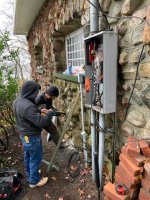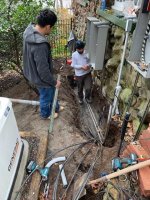jjhoward
Senior Member
- Location
- Northern NJ
- Occupation
- Owner TJ Electric
Hello all;
Some clarification on the size of the GEC in a service to a residence with 2 150 amp main breaker panels.
Is it determined by the size of the Service Entrance Conductor? (yes..?):
Is that the cable from the point of attchment to the top of the meter?
Or is it the cable(s) from the bottom of the meter to the 2 main breaker panels.
This residence has 400 kcm Cu conductors from the POA down to the top of the meter.
Then 2 sets of 2/0 Cu from the bottom of the meter to the 2 seperate main breaker panels for the house.
Are the cables from the POA down to the meter the ones that determine the ground conductor size or is the smaller cables from the bottom of the meter that go to the 2 150 amp panels?
GEC size for 400 Kcm Cu is 1/0.
GEC size for 2/0 Cu is 4 awg.
Which size is the correct GEC size?
Thank you.
Some clarification on the size of the GEC in a service to a residence with 2 150 amp main breaker panels.
Is it determined by the size of the Service Entrance Conductor? (yes..?):
Is that the cable from the point of attchment to the top of the meter?
Or is it the cable(s) from the bottom of the meter to the 2 main breaker panels.
This residence has 400 kcm Cu conductors from the POA down to the top of the meter.
Then 2 sets of 2/0 Cu from the bottom of the meter to the 2 seperate main breaker panels for the house.
Are the cables from the POA down to the meter the ones that determine the ground conductor size or is the smaller cables from the bottom of the meter that go to the 2 150 amp panels?
GEC size for 400 Kcm Cu is 1/0.
GEC size for 2/0 Cu is 4 awg.
Which size is the correct GEC size?
Thank you.




